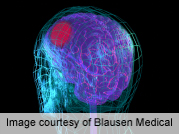
MONDAY, May 13 (HealthDay News) — Sudden numbness or weakness in the face, arms or legs on one side of the body, confusion and trouble speaking are among the signs that someone is having a stroke. The sooner a stroke is recognized and treated, the greater the chance of recovery, experts say.
“When someone has a stroke, they may show either slight or extremely noticeable physical changes,” Dr. Randolph Marshall, chief of the stroke division at NewYork-Presbyterian Hospital/Columbia University Medical Center, said in a hospital news release. “The most effective way to prevent the permanent damage associated with stroke is to recognize the signs of an attack and to seek medical attention immediately.”
Dizziness and trouble walking, loss of vision in one or both eyes and a severe headache that comes on suddenly for no apparent reason are other signs that someone is having a stroke. Early treatment, however, can prevent or possibly reverse the damage caused by strokes. The experts advised remembering the acronym “FAST” to help people recognize a stroke sooner and reduce any long-term damage.
- F for Face: Does someone’s face look uneven?
- A for Arm: Do you notice one arm hanging down?
- S for Speech: Check for slurred speech or other signs of trouble speaking.
- T for Time: Call 911 and seek immediate medical attention.
One of the most common treatments for stroke is tissue plasminogen activator, the “clot-busting” treatment also known as TPA. The drug is injected into an artery or vein to dissolve a clot and restore blood flow to the brain.
Revascularization is another treatment for stroke in which micro-catheters are placed inside the artery to remove blockages. In all cases, immediate medical attention can help reduce the damage caused by a stroke, according to the news release.
Learning how to prevent strokes with certain lifestyle changes can also save lives, the experts pointed out. “Stroke statistics are sobering: It’s the fourth leading cause of death in the United States and the leading cause of adult disabilities,” said Dr. Babak Navi, director of the Stroke Center at NewYork-Presbyterian Hospital/Weill Cornell Medical Center, in the news release.
“On average, someone dies of stroke every four minutes,” he added. “The good news is that approximately 80 percent of strokes can be prevented.”
Lifestyle changes that can significantly reduce the risk of having a stroke include the following:
- Cut back on salt. Reducing salt intake can lower blood pressure, reducing the risk for stroke. Instead of salt, season food with a variety of spices.
- Eat a healthy diet. Reduce LDL (or “bad”) cholesterol levels to improve heart health and reduce the risk for stroke. Cholesterol levels should be 200 milligrams per deciliter (mg/dL) or below.
- Quit smoking. Smokers have twice the risk of having a stroke. Smoking damages blood vessels, increases blood pressure and accelerates the clogging of arteries.
- Exercise. People who are overweight or obese are at greater risk for high cholesterol, high blood pressure, diabetes and stroke. Losing weight can lower the risk for stroke and ease the strain on the circulatory system.
Even with these lifestyle changes, the experts pointed out that people aged 55 years or older are still at greater risk for stroke. Also at greater risk are black people, Hispanics and those with a family history of stroke or “mini-stroke” (also called a transient ischemic attack).
Although strokes are more common in men, women who have strokes are more likely to die from them, according to the news release.
More information
Visit the U.S. National Library of Medicine to learn more about stroke treatment and prevention.

